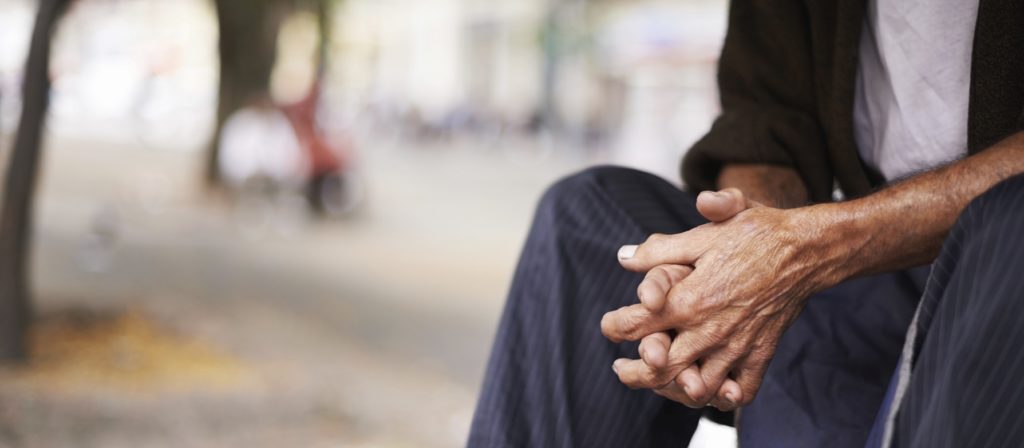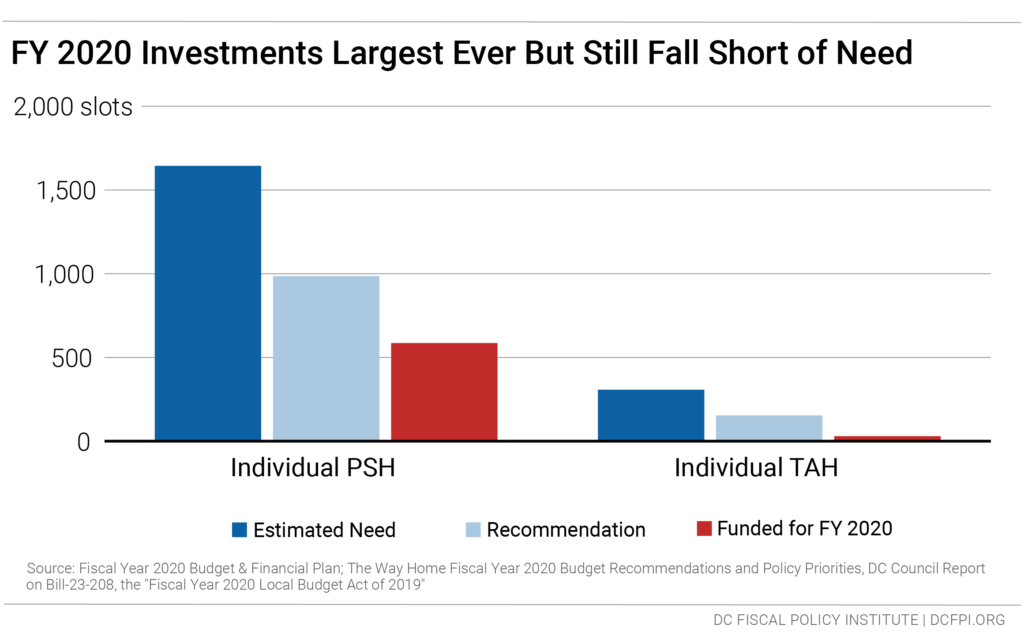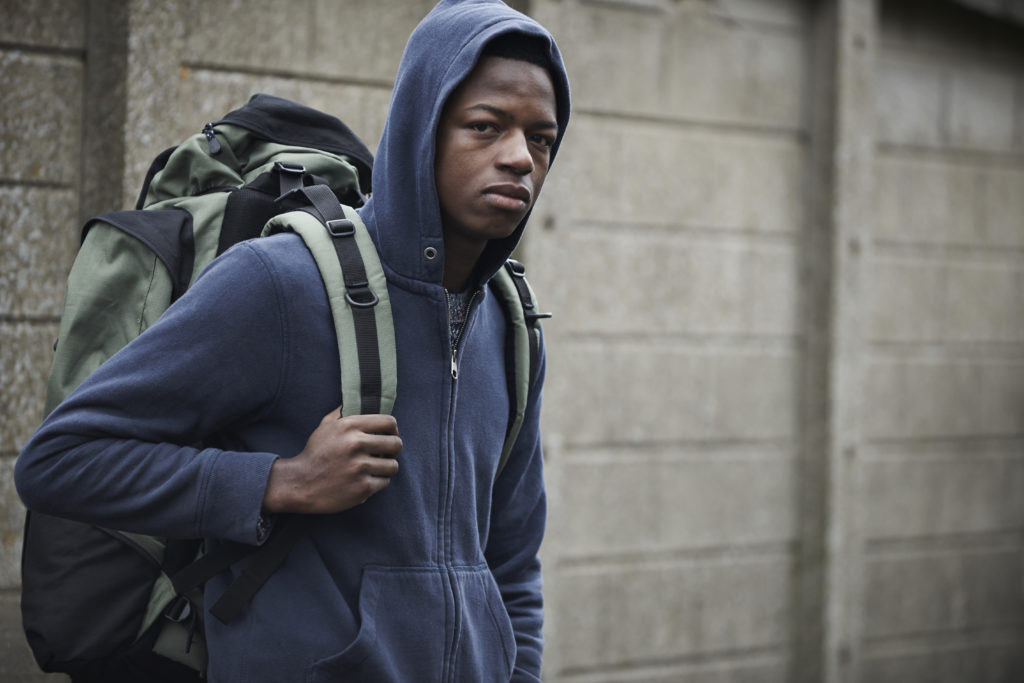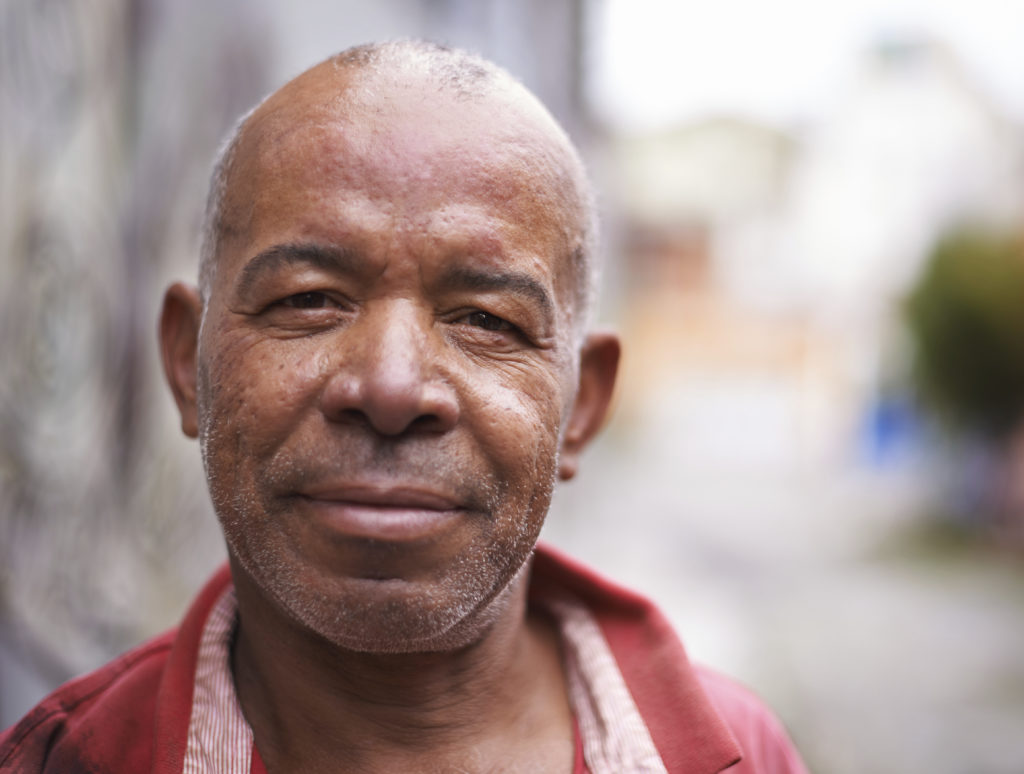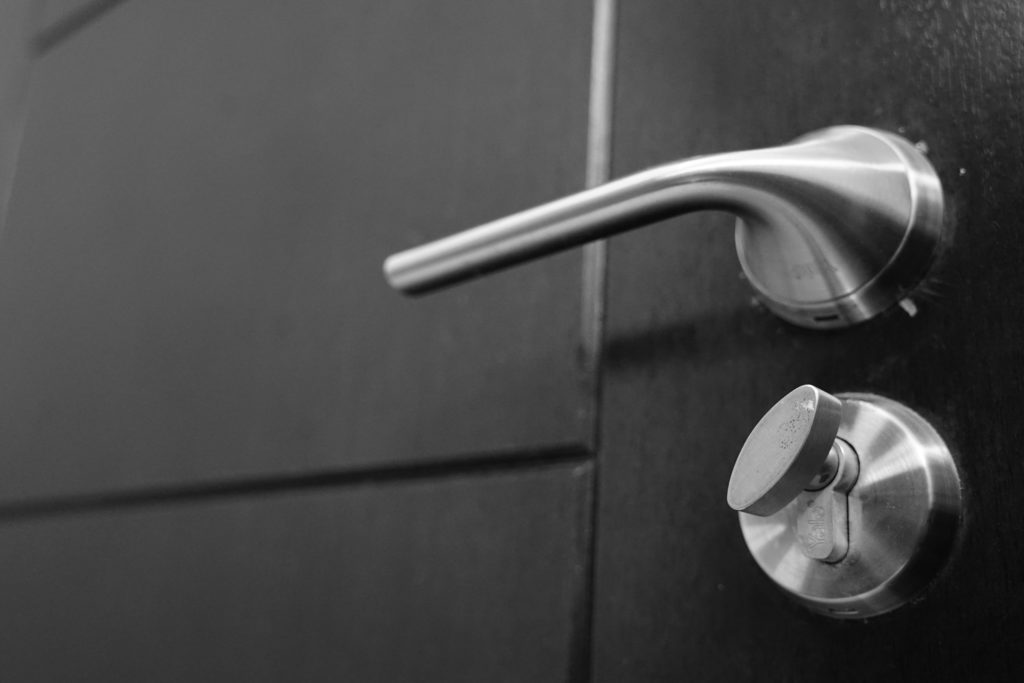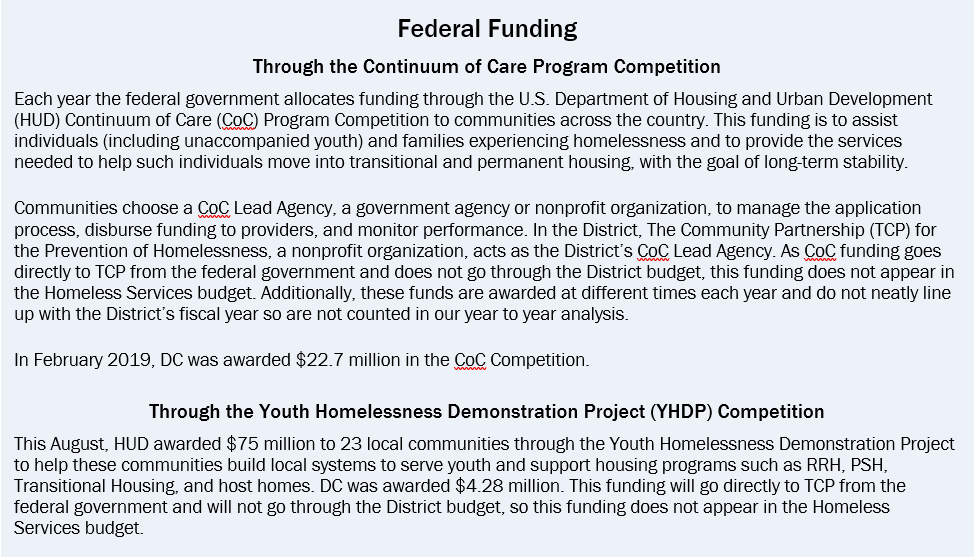Summary:
- Adds the following for individuals:
- $15.9 million for new Permanent Supportive Housing (PSH) units and $737,000 for additional Targeted Affordable Housing units for individuals. While this is a significant investment, it falls short of the need.
- Adds the following for families:
- $6.3 million for 180 new PSH slots, fully meeting the need for PSH among families.
- $5.1 million for 203 new TAH slots. This is well below the number of families experiencing homelessness who need long-term housing help.
- $11.2 million for operating Short-Term Family Housing.
- Adds the following for youth:
- $1.7 million for 50 PSH spots, $2.1 million for 50 transitional beds, and $1.3 million for 60 shelter beds.
- Also includes:
- $7.9 million for Emergency Rental Assistance Program (ERAP), a small increase from last year.
- No dedicated funding for SOAR, which helps individuals secure federal disability benefits
- $400,000 to improve public restroom access.
- $200,000 to develop a new strategic plan for housing or survivors of domestic violence.
- $3.7 million to replace t federal funding that is expiring for street outreach to people with high needs.
- $21,60 for stipends for homeless residents who are members of the Interagency Council on Homelessness Consumer Work Group.
The fiscal year (FY) 2020 budget provides the highest funding level ever for homeless services.[1] This is a recognition of the enormity of this challenge and reflects new investments in Homeward DC, the plan to end homelessness among unaccompanied adults and families and in Solid Foundations, the plan to end homelessness among youth. The Strategic Plans, developed by the Interagency Council on Homelessness (ICH), aims to make homelessness rare, brief, and non-recurring.[2]
But the budget also falls far short of the needs outlined in the Homeward DC Strategic Plan. It provides permanent housing for 616 individuals experiencing chronic homelessness, when the need is over 1,900, which means the budget doesn’t put DC on a path to ending homelessness soon. The budget is notable in that it provides permanent housing to all the 180 families facing chronic homelessness, yet it provides very little help to families that are homeless primarily because they cannot afford DC’s high rents. The new services for youth meet or exceed the targets recommended in DC’s plan to end youth homelessness.
The budget provides substantial new funding to improve dilapidated shelters for individuals and to operate new short-term housing for families.
DC’s services for residents experiencing homelessness fall in four broad categories of services:
The Homeless Services Continuum for Families and Individuals
The District provides a variety of short-term and medium-term services for families and individuals experiencing homelessness. This includes shelter, the Homelessness Prevention Program (HPP), the Emergency Rental Assistance Program (ERAP), Rapid ReHousing (RRH), transitional housing, and other programs. (These programs are described in more detail below.) Many of these services are delivered by private providers, either under contract with the DC Department of Human Services or operate under the umbrella of The Community Partnership for the Prevention of Homelessness (TCP), an intermediary organization.
The Homeless Services Continuum for Youth
This includes family mediation, emergency shelter beds, transitional housing, RRH, Permanent Supportive Housing (PSH), and aftercare services which help youth maintain housing stability after exiting a program. Most of these services are delivered by private providers which either contract with DHS directly or operate under the umbrella of TCP.
Permanent Supportive Housing (PSH)
This program provides long-term housing and intensive case management to residents facing chronic homelessness who would otherwise have difficulty remaining housed. PSH helps people stay in housing and improve their health, which in turn saves a substantial amount of money. DC places some participants in apartments using rental subsidies, and others in buildings developed with District funding. Most of the services are delivered by private providers which either contract with DHS directly or operate under the umbrella of TCP.
Targeted Affordable Housing (TAH)
This provides long-term affordable housing for formerly homeless residents, with no or minimal supportive services. TAH helps residents who need help paying rent after their RRH ends or who no longer need the intensive services provided by PSH but still need help to afford housing.
Budget Takes Steps to End Chronic Homelessness but Falls Short of the Need
A large number of single adults in DC are chronically homeless, meaning they’ve been homeless for a long time and suffer from life-threatening health conditions and/or severe mental illness. Families can also experience chronic homelessness, but it is less common. Among families facing homelessness, the main challenge is low income and the inability to afford DC rents. (See Budget Makes Investments in Family Housing Programs below.)
The approved budget makes new investments towards ending chronic homelessness but falls far short of the estimated need (Figure 1, pg. 2). The budget also is well below the targets set by The Way Home campaign, an advocacy effort to end chronic homelessness in the District in the next four years.[3]
The approved budget includes $15.9 million in new funding to provide PSH to 586 individuals. This is just one-third of the estimated need of 1,644 slots, and it is just 59 percent of the target of 986 slots set by The Way Home campaign. The campaign is seeking to make rapid progress in expanding PSH because the individuals it serves are the most likely to die while homeless.
The approved budget provides $737,000 for TAH for 30 individuals, far below the estimated need of 307 units and The Way Home campaign goal of 154 units.
The budget for RRH remains flat at nearly $4.2 million and will serve an estimated 440 people. RRH for individuals provides housing search assistance, supportive services, and short-term rental assistance, generally for 3 to 6 months. The program aims to move residents out of shelter as quickly as possible, which in turn allows more residents to access emergency shelter. While the Strategic Plan anticipated a need of 2,487 RRH slots, it now appears that more individuals facing homelessness need more help than the short-term aid provided through RRH.[4] This means that the number of individuals who would be best served by RRH is likely to be smaller than estimated in the Strategic Plan. Additionally, the program has faced challenges connecting participants with quality jobs programs. It makes sense to work out these challenges before adding additional slots.
Figure 1.
Budget Makes Investments in Family Programs, But Falls Short of Need
The budget is notable because it provides enough funding to serve all families experiencing chronic homelessness—adding $6.3 million for 180 PSH units for families.
The proposed FY 2020 budget added nearly $3 million for RRH, simply to keep up with increased program costs due to increasing rents, but the Council repurposed this funding (see next paragraph). The total RRH budget is $40.6 million, unchanged from FY 2019. DC’s RRH program for families offers approximately 12 to 18 months of assistance, which is generally longer than for individuals.
The proposed budget included $2.1 million for 80 additional TAH units. The Council also reprogrammed the $3 million addition to the Rapid ReHousing budget to create 123 additional TAH units. While the actual need is difficult to measure due to limited data, it is likely that the number of families experiencing homelessness who need long-term rental assistance is much larger. DCFPI recommended increasing funding to provide TAH to at least 500 families.
Expanded Services for Unaccompanied Youth Experiencing Homelessness
Many youth who experience homelessness do so without their parents or guardians and do not have children of their own. These “unaccompanied” homeless youth fall into two broad categories: those under age 18 and those who are 18 to 24 years old. In DC, youth under age 18 can only access housing and shelter dedicated to this population. Older youth, often called transition-aged youth (TAY), can access both TAY programs and adult housing and shelter.
The proposed budget included $975,000 for 30 new RRH subsidies, but youth stakeholders expressed a desire to experiment with program design before making large increases to the program. So, the Council reprogrammed this funding to other youth housing programs (see below).
The budget adds $1.7 million for 50 new PSH slots, meeting the target set by the DC Alliance of Youth Advocates (DCAYA) based on input from youth and providers, given the number of highly vulnerable youth they identified.
The budget also adds $2.1 million for 50 new transitional housing beds for youth, meeting the target set by DCAYA.
The budget includes $1.3 million for 60 new shelter beds for TAY youth, meeting the target set by DCAYA.
The budget replaces $400,000 in one-time funding in the FY 2019 budget with ongoing funding for services at the new 24-hour drop in center, as well as homelessness prevention and aftercare services. Aftercare provides individually tailored services to formerly homeless youth and their host family or friends to ensure that the housing placement is stable. These services can include conflict mediation and referrals to mental health and other services.
The budget added $100,000 in administration costs and $157,429 to add a youth homelessness program manager.
Finally, the budget does not include $250,000 for a pilot mentoring program, a need expressed by youth experiencing homelessness who provide input to the Interagency Council on Homelessness.
Additional Funding for Operations of New Short-Term Family Housing
The budget adds $11.2 million to support operations of the District’s new short-term family housing sites, six sites that are replacing the now-closed DC General Family Shelter, and the Ward 1 Family Shelter, which replaces apartment-style shelter units that recently closed. The Ward 1 Family Shelter will also include 15 units of PSH for seniors and make renovations to the Rita Bright Family and Youth Center which is adjacent to the new shelter.
Funding to Improve Shelters and Conditions for Individuals
The budget includes a number of investments to improve conditions at dilapidated shelters for singles.
It includes $20.9 million to build a 200-bed replacement for the Harriet Tubman Women’s Shelter. This shelter will be moved to a new site on the DC General campus where the current shelter is located.
The budget adds $3 million to the $8.5 million allocated in last year’s budget for renovations at the New York Avenue Men’s Shelter. These renovations will include the creation of space for daytime programs and a health clinic.
The budget adds approximately $3 million to the nearly $13 million currently allocated to make critical repairs at Emery and Blair Men’s Shelters, including renovating existing bathrooms and replacing ramps to comply with the Americans with Disabilities Act.
The budget adds $8 million to the $40 million allocated to replacing the 801 East Men’s Shelter. This shelter will be moved to a new site on the St. Elizabeth’s Hospital campus to make way for a new hospital.
The budget also includes $870,000 for security enhancements at the Federal City Shelter, also known as the CCNV Shelter. This funding will be used to install cameras, flood lights, and security systems. It will also be used to hire contract security staff.
The budget includes $150,000 to expand medical respite care for single women.
Funding Included for New Domestic Violence Housing Strategic Plan
Funding for shelter and services for survivors of domestic violence is housed in both the Department of Human Services (DHS) and the Office of Victim Services and Justice Grants (OVSJG). The FY 2020 budget includes $200,000 in the OVSJG budget for a strategic plan to enhance access to safe housing for survivors. The budget does not include new dedicated funding for shelter and services, even though domestic violence is one of the leading causes of homelessness. The DC Coalition Against Domestic Violence (DCCADV) called for an investment of $3 million for emergency/crisis housing and $1 million for a Mobile Advocacy Program that provides case management wherever a survivor is—in a mainstream homelessness program, with friends or family, or on their own.
Small Increase to Emergency Rental Assistance (ERAP)
The FY 2020 budget for emergency rental assistance is nearly $7.9 million, a 4 percent increase from the FY 2019 budget when adjusted for inflation. ERAP helps residents facing eviction pay for overdue rent and related legal costs. The program also provides security deposits and first month’s rent for residents moving into new homes.
Increased Funds for Homelessness Prevention
The budget adds $875,000 to Project Reconnect, a program that helps individuals who are newly homeless find alternatives to shelter such as reuniting with friends and families. This will double the program’s budget and will allow the program to serve 1,000 people, twice as many as in 2019.
The budget adds $798,000 to expand the Homeless Prevention Program (HPP) to 266 additional families. HPP works to prevent a family at imminent risk of losing housing from becoming homeless through the provision of stabilizing services and resources.
Budget Replaces Expiring Federal Funds for Street Outreach
Over the past three years, DC nearly doubled its street outreach to individuals experiencing homelessness and living outside, primarily funded through a federal grant. Outreach services primarily target hard-to-reach individuals who do not seek shelter or other homeless services. Outreach workers help these individuals to apply for housing and gain necessary documentation. They also help them connect with vital services like mental and physical healthcare. This federal grant is expiring, but the budget includes nearly $3.7 million to sustain these services.
Funding for Public Restrooms
DC has only three public restrooms that are open 24 hours. This leaves many residents, particularly residents experiencing homelessness, with no place to go. DC recently passed legislation that will increase access to public restrooms.[5] The budget includes $270,000 in capital funds and $130,000 in operating funds to pilot two 24-hour standalone public restrooms in high-traffic neighborhoods and to offer incentives to businesses to open their bathrooms to the public.
No New Funding to Help Residents Apply for Disability Benefits SSI/SSDI Outreach, Access, and Recovery (SOAR)
The SSI/SSDI Outreach, Access, and Recovery program (SOAR) helps individuals who have a serious mental illness, medical impairment, and/or a co-occurring substance use disorder secure federal disability benefits. Because the application process is difficult to navigate, only 14 percent of these individuals are approved on initial application for these benefits. Using the SOAR model, DC has been able to help 73 percent of these individuals secure benefits on this initial application.
In FY 2019, the Department of Human Services found one-time funding to expand SOAR. There is no dedicated funding to continue this expansion in FY 2020 but DHS reports they will be continuing the program.
Stipends for ICH Consumer Work Group Members
The FY 2020 budget includes $21,600 for stipends for residents who have or are currently experiencing homelessness and are members of the Interagency Council on Homelessness (ICH) Consumer Work Group. Members will receive $50 for every ICH meeting they attend to compensate for their time and expertise, as well as to support travel expenses incurred to attend meetings.
[1] In the Approved FY 2020 Budget Toolkit, DCFPI uses the most up-to-date inflation data, which is more current than the data that we used for the Proposed FY 2020 Budget Toolkit. As such, some figures may have slightly changed.
[2] Homeward DC Strategic Plan to 2015-2020 https://ich.dc.gov/sites/default/files/dc/sites/ich/page_content/attachments/ICH-StratPlan2.7-Web.pdf
[3] The Way Home DC http://thewayhomedc.org
[4] Information provided to the Interagency Council on Homelessness
[5] Kate Coventry, The Mayor and Council Should Fund Public Restrooms in the Budget. DC Fiscal Policy Institute, March 7, 2019. https://www.dcfpi.org/all/the-mayor-and-council-should-fund-public-restrooms-in-the-budget/

